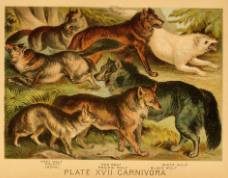The Spooky History of Halloween
September 9, 2018
Halloween has not always been the fun-sized candy and pumpkin filled holiday that it is today. In fact, it started out much different than one might think. According to History.com, our spookiest holiday was most likely a Pagan Holiday to begin with, but it was not called Halloween- it was referred to as the festival of Samhain (celebrated by the Celtics). On the evening of October 31st, the Celts would dress up in costumes made out of animal pelts, and would sacrifice things to the celtic gods, like crops and animals, in a bonfire. Samhain was celebrated because the people believed that the ghosts of the dead returned to Earth that day.
Obviously, to reach modern day Halloween, this Celtic festival had to transform in various ways. The first major change it went through was after the Catholic Church took over the area and Christianized Samhain. They combined two of their Roman festivals, that celebrated the dead, with the festival of Samhain to form All Saints’ Day. The traditions of this newly named holiday and the days surrounding it were very similar to Samhain, except people would often wear costumes that resembled saints and demons, rather than just animal pelts. This holiday was also referred to as All Hallows Day, and the night before it was All Hallows Eve. The name “Halloween” came from the shortening of All Hallows Eve.
Other traditions that resemble modern Halloween practices began during this time as well. The act of trick or treating has ancient cousins known as “souling”, “mumming”, and “guising,” that are described by livescience.com. All of these were different variations on people begging for food. The differences were that “souling” involved people getting food if they prayed for the homeowners’ dead relatives. The people souling would receive a treat called soul bread for their prayers. The practices of “mumming” and “guising” included people putting on disguises or costumes and begging at houses for food. In turn, these evolved into trick or treating when Irish immigrants came to America and rekindled such traditions. However, trick or treating did not become the candy gathering event that it is today until after World War II.
Although the ancient origins of trick or treating bear large similarities to the modern practice, they obviously differ greatly because the vast majority of children trick or treating don’t need the candy as sustenance. This has become a more luxurious tradition, that is easier sustained by the rich than the poor, for the enjoyment of children. This halloween tradition demonstrates how the world has changed greatly over time.
Our world has changed in the aspect of beliefs as well. Halloween has always been about the ghosts and the ghouls, apparently even more so in the past. But, the ancient origins of this classically eerie holiday were this way partially because people didn’t understand the transitions between seasons as well, so they were scared and came up with explanations for it. Now that we have more historical context for this phenomena, we are only able to to enjoy the remnants of these beliefs and have fun with the dark and spooky aspects of it.
Jack-O-Lanterns are a good example of how a very spooky tradition evolved into only a semi-scary tradition. As told by Boston.com, legend has it that a man named Jack repeatedly tricked a demon and thus was banished from heaven and hell FOREVER! Because of this, he was left in eternal night. The Jack-O-Lantern aspect comes in because the only light he was given was from coal burning inside of a carved turnip. People in Western Europe began to carve vegetables such as turnips and potatoes to scare off the spirit of Jack. When the Irish immigrated to America they began to carve pumpkins instead (because that was what was available). The pumpkins carved now are no longer for scaring off the spirit of Jack, and are instead used to decorate your porch in the spirit of the season.
Halloween has a rather complex history on how it came to be. This holiday has evolved greatly over time and continues to evolve today, with our modifications of traditions. This year, as you participate in your favorite October 31st traditions, I hope you think about how spooky this holiday really is.
Sources:
http://www.history.com/topics/halloween/history-of-halloween
https://www.livescience.com/40596-history-of-halloween.html
The History of The Jack-O-Lantern (& How It All Began With a Turnip)









































































































































